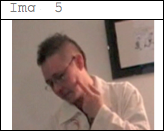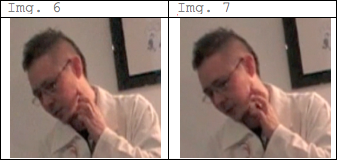 Social Interaction.
Video-Based Studies of Human Sociality.
Social Interaction.
Video-Based Studies of Human Sociality.
2019 VOL. 2, Issue 1
ISBN: 2446-3620
DOI: 10.7146/si.v2i1.113957
Social Interaction
Video-Based Studies of Human Sociality
Some theoretical and methodological challenges of transcribing touch in talk-in-interaction
Luca Greco (Université de Lorraine, Metz, France)
Renata Galatolo (Università di Bologna, Italy)
Anne Sylvie Horlacher (Université de Bâle, Switzerland)
Vanessa Piccoli (ICAR Lab, Lyon, France)
Anna Claudia Ticca (LIDILEM Lab, Université de Grenoble Alpes / ICAR Lab, Grenoble and Lyon, France)
Biagio Ursi (ICAR Lab, Ecole Normale Supérieure de Lyon, Lyon, France)
Victoria University of Wellington
Abstract
In this paper, we deal with theoretical and analytical issues raised by the transcription of touching practices. We will focus on both transcription resources and on how these resources are suitable for representing relevant analytical issues in studying touch. In particular, we are faced with methodological and epistemological issues at work with the visual and iconic dimensions of transcription systems and their relation with sensorial modality – touch – that can be, according to the context, purely visual (touch for showing and mapping), tactile (touch for testing and diagnosing), and tactile and visual (touch for orienting and guiding).
Keywords:
Touching practices, transcription, description, multimodality
1. Introduction
Since the seminal paper of Elinor Ochs in 1979, scholars have been interested in epistemological, theoretical and analytical questions raised by the practice of transcribing social interaction (see Bürki & De Stefani 2006, Hepburn & Bolden 2017, among others). As this literature claims, transcribing social interaction is not just a device to represent the interactional and multimodal dimensions of social practices, but it also implies theoretical issues vis-à-vis language and action, and entails analytical choices. Transcription practices transform audio and video recordings (primary data) into spatial, iconic and textual representations (secondary data) of talk and bodily conduct in interaction. Scholars have highlighted how transcription practices are necessarily selective (Duranti 1997) as far as they imply choices in terms of phenomena to be transcribed and the transcription’s granularity. Being at the service of analysis, transcription must be conceived as essentially provisional, as it must be changed according to analytical objectives. As a system of representation, transcription questions the ways through which scholars spatially and graphically represent languages that are not written in the Roman alphabet (Traverso 2002, Hepburn & Bolden 2017), or speech practices in which the embodied dimension of talk is a central feature for the analysis. Being the result of visual and hearing professional practices (Mondada 2008), transcription can constitute a creative assemblage of images, drawings and texts, as in Charles Goodwin’s work (2017). Finally, political and ethical issues are also implied in transcription practices, as far as they question how to represent the talk of stigmatized and/or impaired people, with very important consequences for both the research and the life of the social actors involved (Bucholtz 2000).
With the emergence and consolidation of the study of multimodality in conversation analysis (C. Goodwin 2010, Depperman 2013, Heath & Luff 2013), questions related to the transcription of bodily behaviors and their interweaving with vocal, verbal, material and spatial resources continue to attract the attention of scholars (Mondada 2018). In this sense, two main intertwined issues arise.
First, the implications for transcription practices of the study of corporeal resources, such as gaze (Goodwin 1978, Rossano 2012), laughter (Jefferson 1985, Glenn 2003), crying, inhalation and exhalation (Hepburn & Varney 2013, Hepburn & Bolden 2017) in relation to the emergence of new topics such as multimodality in mobile interactions (Haddington et al. 2013), human-animal interactions (Mondémé 2016), and the study of sensory dimensions, such as taste (Liberman 2018) and tactility (Goodwin & Cekaite 2018). Second, a holistic (vs. taxonomic) approach to multimodality as an opportunity to rethink transcription practices (ICOR 2013, Mondada 2014a) in order to account for the synchronicity of semiotic resources and to make sense of vocal, verbal, material, visual, kinetic and tactile resources as a relevant whole (i.e. semiotic fields, cf. Goodwin 2000, or multimodal gestalts, cf. Mondada 2014b). As with other semiotic resources, touching practices never occur in isolation, so that a fine-grained description of tactility in interaction should account for its embeddedness in more complex haptic formations (Cekaite 2016) and in the surrounding interactional and material environment.
Previous works on tactility in interaction strike us for the lexical richness used to describe this resource. From the pioneering study of David Efron (1972) on bodily conducts in traditional Eastern Jews community based in New York to more recent works on touch as a tool to construct meanings (Streeck 2009) and to regulate parent-child interactions and teacher-pupil exchanges (Cekaite 2010, M.H. Goodwin & Cekaite 2018), we observe an impressive diversity in lexical choices used to describe touching practices. Here are some examples of such a rich lexicon: hugging, grasping, handling in workplaces to account for touching practices with objects (Streeck 2009), stroking and tapping, grooming, palpating and “(parental) shepherding moves” in interactions with kids in family settings (Cekaite 2010).
Nonetheless, such rich linguistic repertoire fails to describe the diversity of details observable in social practices. This is the case with the spatial and temporal dimensions of touching practices, their boundaries, their continuous or discontinuous nature, their intensity and duration, and their relations with other intertwined corporeal and verbal practices.
Moreover, some dimensions of touching practices, such as pressure and intensity, since they necessarily escape the visual access (of the analyst), critically question the appropriateness of video-recordings as the sole mode for documenting them. For all these reasons, visual representation and the lexical description of touching practices raise important methodological and epistemological issues in social sciences, which include how to offer an “emic” (vs. “etic”) description of the social practices accomplished in interaction.
In the remainder of this paper, we will discuss some issues emerging from the transcription of touching practices. We will focus on both transcription resources - choice of verbal descriptions and/or coding of touching relevant cues - and on visual representations related to the use of screenshots and videos. Finally, we will discuss whether/how such resources are suitable for representing relevant analytical issues in the study of touch.
2. The Data
The video-recorded data used in this paper are drawn from different corpora collected in various ethnographic settings: make-up activities in drag king workshops between novices and experts (Greco corpus), guided visits with visually impaired children (Ticca & Ursi corpus[i]) and physical examinations of amputees in medical setting (Galatolo corpus). Data are in French (Greco, Ticca & Ursi corpora) and in Italian (Galatolo corpus). In this paper, we adopt a conversation analytical approach (for an introduction, cf. Sidnell and Stivers 2013) and a multimodal perspective (Streeck, Goodwin, LeBaron 2011). We basically use the transcription conventions proposed by Jefferson (2004) for verbal conducts, and by Mondada (2014a) for multimodal behaviors.
3. The analysis
The three corpora, drag king workshop, guided visits with visually impaired children and physical examinations of amputees correspond to three different types of touching practices:
i) a “touch for showing and mapping” (Image 1, Greco corpus) in which the expert’s touch on his own face has the function of showing to the co-participant (the novice) the transformation s/he will have to accomplish on her/his own face;
ii) a “touch for orienting and guiding” the hands of visually impaired children while reading braille on a sign-post (Image 2, Ticca & Ursi corpus);
iii) a “touch for testing and diagnosing” (Image 3, Galatolo corpus) the patients’ sensations of pain or discomfort in medical encounters with amputees:
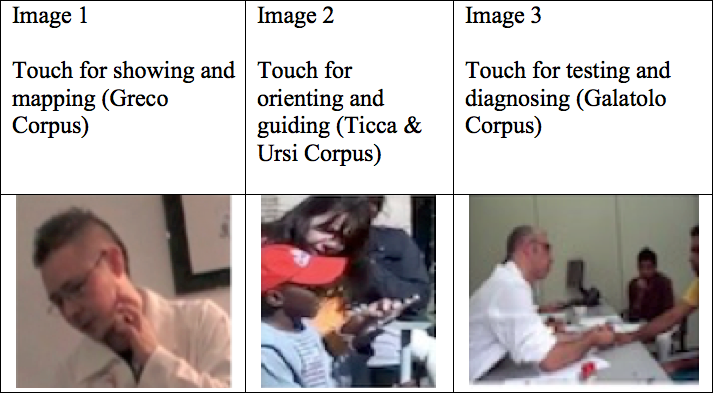
The choice to discuss the main transcription issues raised by the study of touching in interaction in three different corpora is explained by the fact that these corpora differently raise the question of the adequacy of depicting touching phenomena. Indeed, both the video documentation and the transcription systems are visual representations of the interaction and this may be problematic for the study of touch. In particular, this may be more or less problematic according to the empirical dimensions of touching practices that participants mobilize within an activity in context, while they are touching their own body or other bodies. In touching practices, as Gibson (1962) and Lederman & Klatzky (1987) have shown, we are faced with two dimensions: a sensorial one, which is obtained through touching a surface, and a kinesthetic one, which refers to the movement of the hand and the muscular work done in touching a surface. The term “haptic” – which we borrow from Gibson (ib.) and Lederman & Klatsky (ib.) - refers to such sensorial and kinesthetic dimensions, at work on and in the world through touch. What is particularly relevant for our discussion is that the sensory sub-system is hardly approachable through video documentation on its own.
The order in the data presentation – drag king workshops, guided visit with visually impaired children, and medical encounters with amputees – reflects a crescendo in the degrees of the mismatch between the members’ touching activities and the researcher’s visual access to the data.
In the drag king corpus, the touching activity is mainly oriented to showing something. The touch shows and draws different anatomical areas on the speaker’s face that are relevant for the gender transformation in action. In this case, the visual dimension of touching is equally accessible to both the participants and the analyst, since no other dimensions of the touching practice are at stake. Instead, in Ticca & Ursi corpus the touch guides the hand of the visually impaired child in reading the braille signs, while in Galatolo data, the touch stimulates and tests the patient’s sensations. Especially in this last corpus, the touching practice is strongly oriented to the sensorial dimension of touch, so that the analyst and the reader’s visual access to data, both through video recordings and transcriptions, may show their limits.
It is worth noting that these three types of touching activities – touching for showing and mapping (Greco corpus), touching for orienting and reading (Ticca and Ursi corpus), touching for testing and diagnosing (Galatolo corpus) – differently entail the sensorial dimension of touch (Gibson 1962), whereby they differently challenge the visual and linguistic (namely lexical) representations of such touching practices. In the next sections we will discuss the limits of the current transcribing system and propose some alternatives and solutions.
3.1. The use of verbal descriptions and screenshots in haptic practices transcriptions
The excerpt below focuses on the first part of the making up activity in drag king workshops[ii].
In this case, the touching activity takes the form of a pointing gesture that shapes and maps out some of the speaker’s face regions. Here, touch is embedded in a demonstration practice. In this context, the expert (Max) shows, the possible forms and contours of the novice (Camille)’s beard:







It is worth noting that these touching practices accomplished on Max’s face – which we have described in the transcription as pointing, sliding, and tapping – project the actions that will be realized by Camille on her/his own face. Such gestures, in their diversity, have the characteristic of (a) shaping and cutting the face into micro spaces relevant for its transformation, and of (b) being temporally organized and structured. Such gestures are accomplished in a continuum.
The activity is also accomplished by some instructions (l. 1 “tu commences ici” [you begin here], l. 6 “tu fais un point ici” [you make a point here]) and by localizing (i.e. indexing) the relevant spots on Max’s face, which offer Camille a starting point for her own bodily transformation (l. 1 “ici” [here], l. 4 “là” [there], l. 6 “ici” [here]). This initial move is focused on “the search of the jaw” and it’s a moment in which Max imagines a more squared form of his jaw (l. 7-8). Some analytical issues can be raised from this excerpt.
The choice of the relevant verbal description for the gesture under scrutiny is a primordial aspect in transcription. We could describe Max’s gesture as “drawing a line from the top to the bottom of the jaw”, or “pointing from the top to the bottom of the jaw”. The choice of using different lexical items such as “slides” (l. 1, 2, 3, 7, 8), “taps” (l. 6), “points” (l. 4) allow us to highlight the temporal unfolding of each practice.
Another relevant aspect is the use of screenshots. While solving some semantic problems in lexical description, the screenshot irreducibly discretizes the continuity of touching. Indeed, they highlight the dimension of pressure in touching practices, in showing the reaction of the skin to the touch (cf. images 4, 5), to the detriment of the overall configuration, which is largely related to a fluid movement.
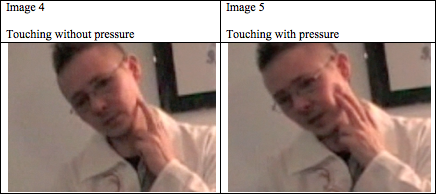
Similarly, in excerpt 2 below we show how touch changes according to the deployment of the activity, with a concomitant evolution and modification of the hand configuration on the touched surface. Given the complexity of the haptic practice, we opted for a descriptive transcription (rather than a more typical ‘granular’, symbolic transcription), accompanied by the illustration of the corresponding gesture through screenshots (l. 3-4, images 1-4). This excerpt is drawn from a guided visit in a garden with visually impaired children, aged between 8 and 10 years, accompanied by the museum guide and their school teacher. Here only the teacher (TEA) and one of the pupils, Kevin (KEV), are present:

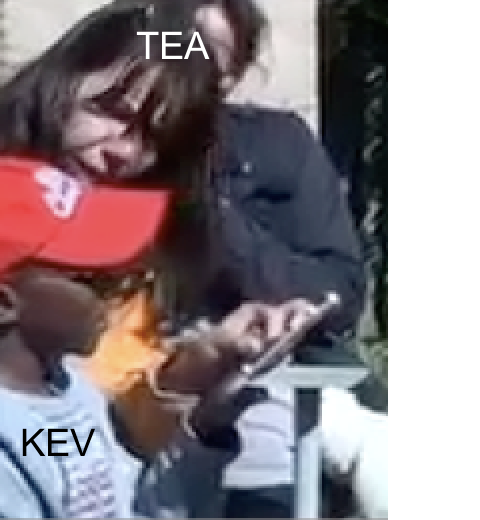
#1
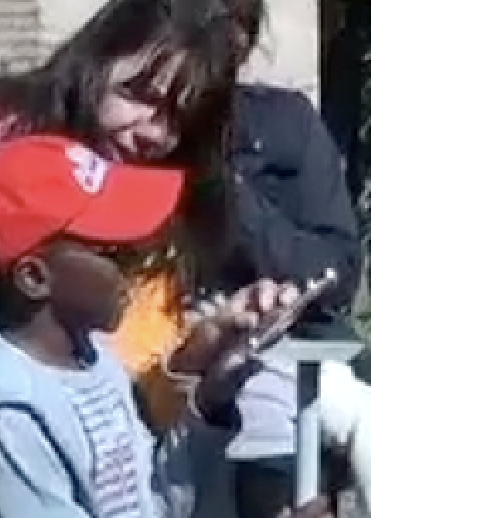
#2
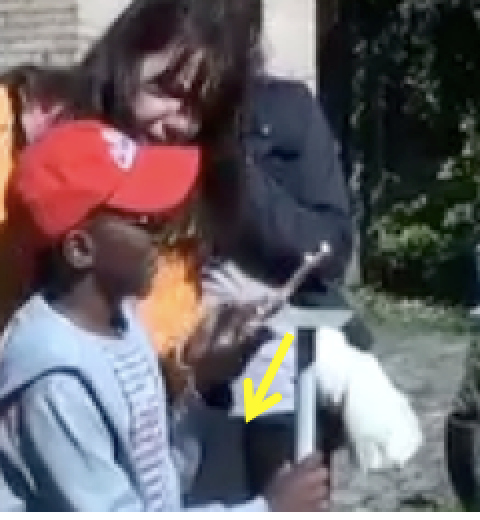
#3

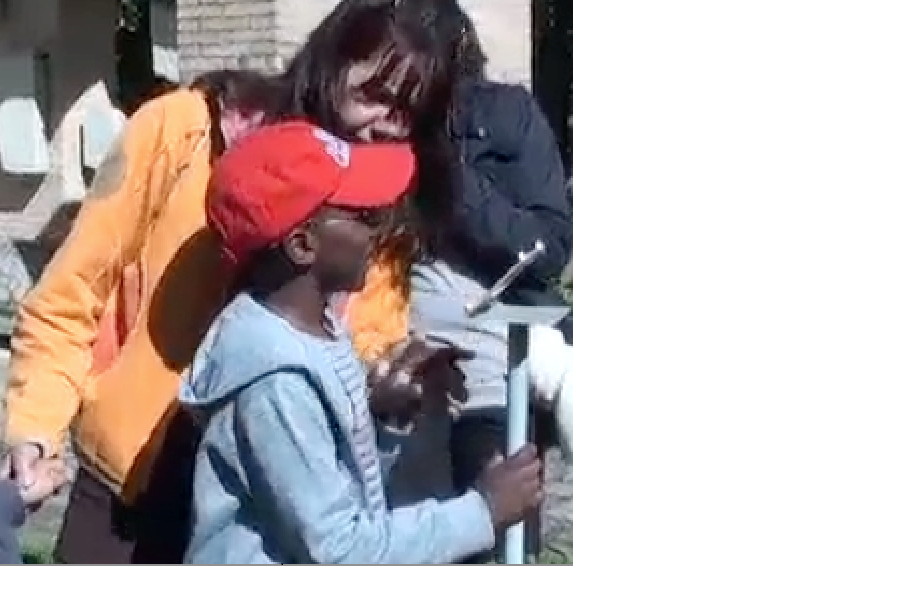
#4
We consider that graphic elements are also useful to point out the temporality and trajectory of the hand movements, as shown below (images 5 and 6, the latter offering a close up of the ongoing movement).
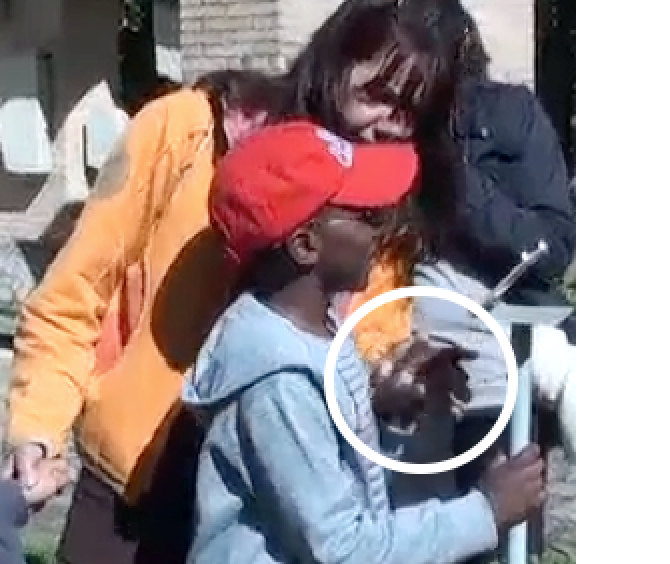
|

|
|
#5 00:21:55:90 |
#6 00:21:55:92 |
In this case, we provided no transcription for this haptic practice. Haptic configurations are highlighted using white circles in the pictures, signaling analytical details to readers. Our aim is to show how the transition from one activity (reading with the hand) to the next (discovering a new object with the same hand) is constructed through the change in hand configurations: first, the teacher holds Kevin’s hand and guides him towards the sign-post, then he guides him through the reading activity on a Braille sign (images 1, 2 in transcription highlight the precision grip of the teacher’s hand, while she guides Kevin’s fingers). Finally, through a notable change in the way the teacher takes Kevin’s hand, as a whole body part, she shifts progressively into a different spatial configuration and into a new activity. This allows a movement downwards and accompanies the child’s hand and body towards the plant whose name has just been read (images 3, 4, 5 and zoomed details in 6) and that will now be touched.
In this corpus, the screenshot turns out to be useful to represent the “navigational touch” orienting the hand of the children towards the Braille sign. However, if we want to focus on finer details, such as contact between the guide and the children’s hands touching the Braille signs, zoom effects need to be added.
In the next corpus, the use of screenshots showing the type and area of contact between the doctors’ hands and the patients’ limbs are integrated by ad hoc graphical symbols addressing the deployment of the haptic activity over time.
In the data, while examining the patient’s forearms, the orthopedic surgeon touches the patient’s limb to induce sensations for gathering sensory information, whereby the interactional focus, for both doctors and patients, are the patient’s haptic sensations provoked by doctors’ tactile stimulation[iii]. In the excerpts below, the focus is the aspectuality of doctors’ tactile stimulation of the patients’ limb. We borrow the linguistic category of aspect in order to address the deployment of touching activity over time, which implies the description of pressure and contact area (for example, rubbing or tapping), its pace (continuous or punctual stimulation), and its duration.iii
As well as for other aspects of touching practices, the transcription of the aspectuality implies a lexical choice. Lexical items address the type and area of contact: for example, “rubbing” refers to prolonged contact with the touched surface though a continuous movement, while “tapping” refers to a punctual movement entailing a brief contact.
Another important dimension is pace, which is the number and duration of each occurrence of tactile stimulation. Mondada’s multimodal transcript conventions have been supplemented here with graphical symbols concerning pace. This is graphically represented by the number and length of minus signs. While the total duration of the touching stimulation is the same, the deployment of the unfolding haptic activity may differ in terms of pace.
In the transcript, the sequentiality of different multimodal behaviors, such as gaze, touching and facial expressions are also represented with ad hoc symbols[iv].
In excerpts 3, 4 and 5, we show three types of the aspectuality of tactile stimulation: continuous, punctual and hold tactile stimulation.
3.2.1 Continuous tactile stimulation
Excerpt 3 shows an example of continuous tactile stimulation:

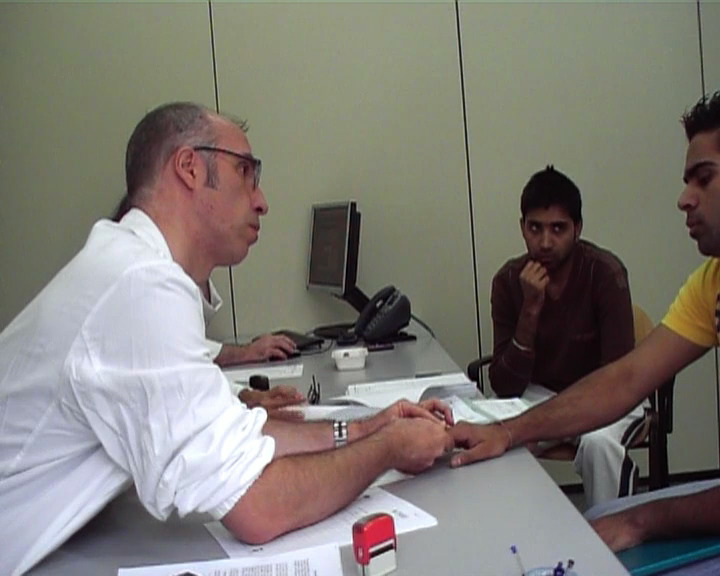
|
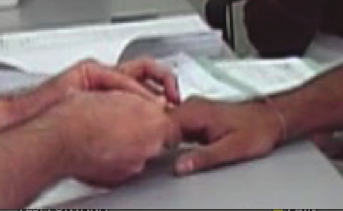
|
|
IMG. 1 |
ZOOM IMG. 1 |
The gesture of rubbing is accomplished, continuously, from the beginning of S’s question at line 1 until the initial part of P’s turn, at line 2. While the duration of the gesture may be represented graphically (we chose to represent it by a continuous line of dots), the screenshots (Img.1 in transcription) representing the tactile stimulation help to show the hand shape and the movement pattern of the rubbing gesture.
In the transcript, different resources are used to represent different dimensions of the touching stimulation: the lexeme “grab” and the images are used to represent hand shape and movement patterns, whereas graphical elements in the multimodal annotation refer to pace and duration.
3.2.2 Punctual tactile stimulation
In the excerpt below, we show an example of punctual tactile stimulation.
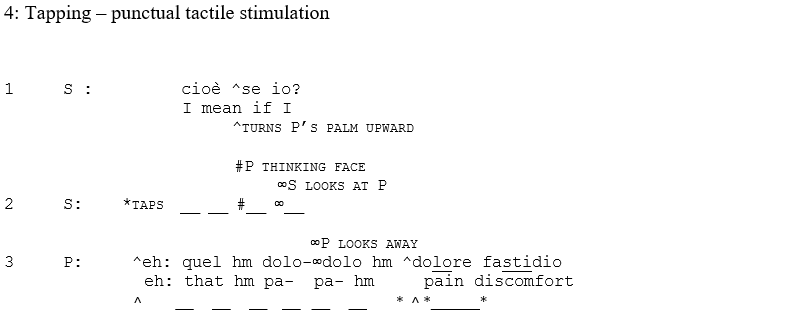
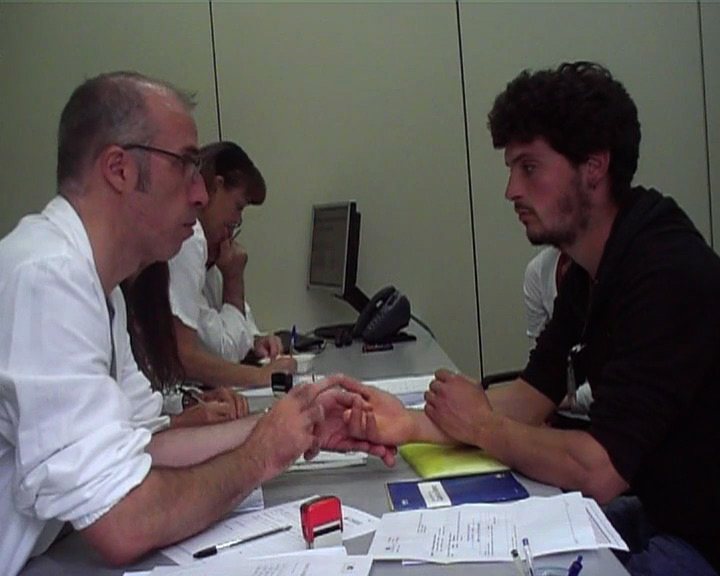
|
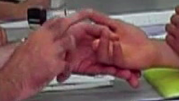
|
|
IMG. 2 |
ZOOM IMG. 2 |
In the example, at line 2 S taps repeatedly on the patient’s limb, until the last occurrence of the word “pain” is produced (line 3), in correspondence of which S remains in the tapping position, maintaining the gestural stimulation temporarily “frozen” (Hepburn & Bolden 2017)[v].
Similarly to example 3, even in this case the shape of the hand and the movement pattern are lexically described by “tapping” and shown in the screenshot, while the pace and the number of repetitions of the tactile stimulation are graphically represented.
3.2.3 Temporarily frozen tactile stimulation
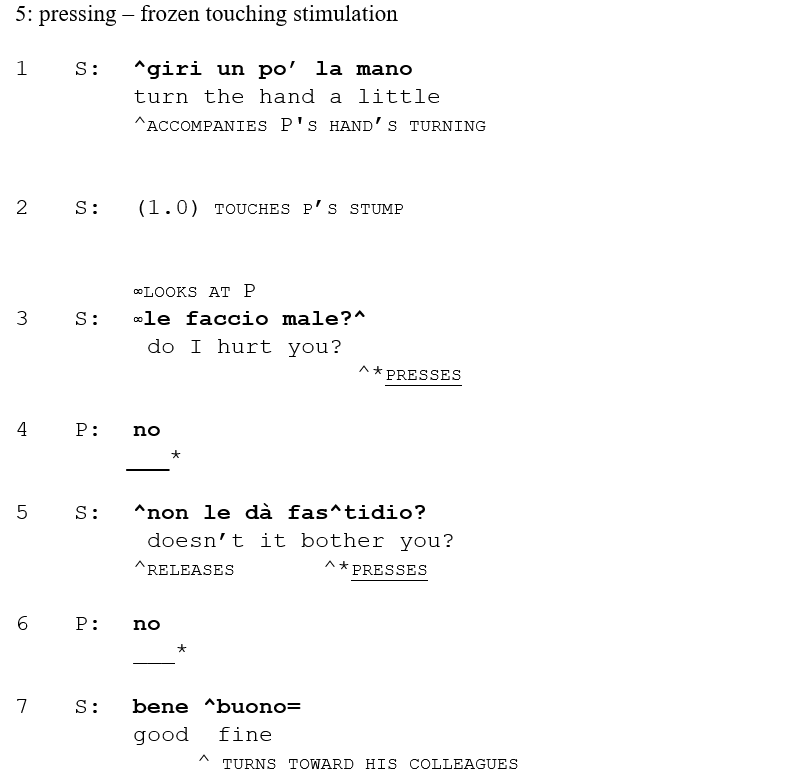

In extract 5, to stimulate the patient's feelings and reactions, the surgeon maintains the pressure on the patient’s hand for 0.5 sec (l.3). While the trajectory and the duration of the doctor’s tactile stimulation of the patient’s limb are both visible in the data, the strength of the pressure is not directly visible but may only be inferred from the grimace on the surgeon’s face while pressing on the patient’s hand (img. 3a a zoom on surgeon’s face):
|
Image 3a a zoom on surgeon’s face
|
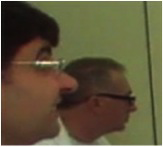
|
The surgeon’s releases the patient’s hand once he has obtained his response at line 4. S then repeats the stimulation, but substituting “do I hurt you?” (l. 3) with “any discomfort?” (l. 5). The same stimulation is thus used in correspondence with a different verbalization of the possible patient’s sensation.
If screenshots seem to be more appropriate to represent the temporarily frozen tactile stimulation, for the representation of the absence of movement, however, we are faced with their inadequacy. The “frozen” effect is obtained through the act of highlighting the “remaining in” or “maintaining the” position, which remains difficult to catch using motionless representations.
An alternative and effective solution to the inadequacy of the aspectuality’s representation of tactile stimulation by transcription associated with screenshots would be to associate the transcription with the video. In this case, all the features composing the aspectuality of haptic practices – type of contact, pace and duration – are supported by the same device. Or, they could be (re)presented by GIF methods, where the repetition device allows the recipiendary to focus her/his attention on particular details of touching practices.
The video data can capture the multimodal complexity of haptic practices and the interrelationship between the various dimensions. They also make other forms of representations, such as transcripts, stills and graphical symbols, recover their function of being mere supports to highlight the phenomena focus of the analysis.
4. Conclusions
In this paper, we approached the question of transcription in social interaction through the description of tactile practices in a variety of social contexts. We focused on temporal, spatial, aspectual, lexical, material, technological and iconic issues at work in tactile practices. The complexity of these practices calls for a closer attention to new and differentiated degrees of granularity, for updating transcription conventions but also for new ways of representing social practices, of which touch is just one among many others. However, the questions approached in this paper are not new. Anthropologists such as Gregory Bateson and Margaret Mead (1942), pioneers in visual representing methods, or Clifford Geertz (1973), who call on scholars for dense descriptions approaching the hermeneutical circle of social actions, are sources of inspiration for renewing the emic dimension in transcription practice and for finding a vernacular multimodal lexicon in order to represent the “internal” viewpoint of social actors.
We showed that the transcription of touching practices requires great creativity in finding the best way to represent a temporal process, decomposing spatial surfaces, adapting to the materiality of bodies and objects, and interacting with, therefore calling for, new iconic and technological ways of representation. From a methodological perspective, we have proposed frames and graphic means as scientific tools allowing us to track and highlight haptic configurations, and to focus on hand and body movements (by zooming in on hands and touched objects, or using graphic resources such as arrows, circles, etc.). We still have the problem of representing and accessing some features of touching, such as its intensity and aspectuality. These dimensions turn out to be primordial in settings such as therapeutic ones or those with impaired participants, in which touching becomes a sophisticated resource to transfer and receive micro pieces of information relevant to build a common understanding of the activity underway. From a descriptive point of view, we question to what extent it is relevant to transcribe the details of hand configurations at a given moment in time, the respective positioning of fingers and palm, the relative location of the touched object/the anatomical designation of the touched body part, or whether it is more straightforward to just represent the gesture through screenshots. We think that such choices depend on both the aims of the analysis and the type of data available in terms of quality, degree of visibility of the observed feature, etc. Concerning haptic practices, where sensorial and the kinesthetic dimensions are relevant and intertwined, two main observations should be made. If the kinesthetic dimension is accessible and transferable through visual representation methods, this is less the case for the sensorial dimension, a central feature in Ticca & Ursi and Galatolo examples. In fact, as we have pointed out in this paper, this dimension remains visibly inaccessible in the data, as well as in the transcript and in iconic and visual representations. From a theoretical perspective, the haptic dimension of touching challenge our ways to describe, categorize, and represent multimodal practices and it drives us to (re)think in a more effective and relevant way how to represent the behaviors of social actors. Moreover, focusing on transcription through the lens of touching practices challenges our way to think about to transcription as a multisemiotic assemblage of representation and description devices and actualizes the theoretical and methodological issues raising in multimodality and multisensoriality in interaction.
Bibliography
Bateson, G., Mead, M. (1942) Balinese Character. A Photographic Analysis, New York, New York Academy Science.
Bucholtz, M. (2000) The politics of transcription. Journal of Pragmatics, 32, 1439-1465.
Bürki, Y, De Stefani, E. (eds.) (2006) Trascrivere la lingua / Transcribir la lengua. Dalla filologia all’analisi conversazionale / De la Filología al Análisis Conversacional. Bern, Peter Lang.
Cekaite, A. (2010) Shepherding the child: embodied directive sequences in parent-child interactions. Text & Talk, 30(1), 1-25.
Cekaite, A. (2016) Touch as social control: Haptic organization of attention in adult-child interactions. Journal of Pragmatics, 92, 30-42.
Depperman, A. (ed.) (2013) Conversation Analytic Studies of Multimodal Interaction. Special Issue Journal of Pragmatics, vol. 46, Issue 1, 1-172.
Duranti, A. (1997) Linguistic Anthropology. Cambridge, Cambridge University Press.
Efron, D. (1972) Gesture, Race and Culture. A tentative study of some of the spatio-temporal and “linguistic” aspects of the gestural behavior of Eastern Jews and Southern Italians in New York, living under similar as well as different environmental conditions, The Hague-Paris, Mouton.
Geertz, C. (1973) The Interpretation of Cultures: Selected Essays. New York, Basic Books.
Gibson, J. J. (1962) “Observation on active touch”, Psychological Review, vol. 69. No. 6: 477-491.
Glenn, P. (2003) Laughter in interaction, Cambridge, Cambridge University Press.
Goodwin, C. (1979) The interactive Construction of a Sentence in Natural Conversation. In G. Psathas (ed.) Everyday Language : Studies in Ethnomethodology (pp. 97-121). New York, Irvington Publishers.
Goodwin, C. (2000) Action and embodiment within situated human interaction. Journal of Pragmatics, 32, 1489-1522.
Goodwin, C. (2017) Co-operative Action, Cambridge, Cambridge University Press.
Goodwin, M. H., Cekaite, A. (2018) Embodied Family Choreography. Practices of Control, Care, and Mundane Creativity, New York, Routledge.
Groupe ICOR (2013) Conventions de transcription, <http://icar.cnrs.fr/projets/corinte/documents/2013_Conv_ICOR_250313.pdf>
Haddington, P., Mondada, L., Nevile, M. (eds.) (2013) Interaction and Mobility. Language and the Body in Motion, Berlin, De Gruyter.
Heath, C., Luff, P. (2013) Embodied Action. In J. Sidnell, T. Stivers (eds.) Handbook of Conversation Analysis (pp. 283-307). Malden, Blackwell.
Hepburn, A. Varney, S. (2013) Beyond ((laughter)): Some notes on transcription. In P. Glenn, E. Holt (eds.) Studies of Laughter in Interaction (pp. 25-38). London, Bloomsbury.
Hepburn, A., Bolden, G. (2017) Transcribing for Social Research, London, Sage.
Jefferson, G. (1985) On the interactional unpackaging of a ‘gloss’. Language in Society, 32, 435-463
Jefferson, G. (2004) Glossary of transcript symbols with an introduction. In G. H. Lerner (ed.) Conversation Analysis: Studies from the first generation (pp. 13-23). Philadelphia, John Benjamins.
Lederman, S.J. & Klatzky, R. L. “Hand movements: a window into haptic object recognition”, Cognitive Psychology, 19(3): 342-368.
Liberman, K. (2018) Objectivation practices. In Social Interaction. Video-based studies of human sociality, vol. 1, Issue 2. https://tidsskrift.dk/socialinteraction/article/view/110037/159343
Mondada, L. (2008) La transcription dans la perspective de la linguistique interactionnelle. Cahiers de l’Université de Perpignan, 37, 78-110.
Mondada, L. (2014a) https://mainly.sciencesconf.org/conference/mainly/pages/Mondada2013_conv_multimodality_copie.pdf
Mondada, L. (2014b) The local constitution of multimodal resources for social interaction. Journal of Pragmatics, 65, 137-156.
Mondada, L. (2016) Challenges of multimodality: Language and the body in social interaction. Journal of Sociolinguistics, 20(3), 336-366.
Mondada, L. (2018) Multiple temporalities of language and body in interaction. Challenges for transcribing multimodality. Research in Language and Social Interaction, 51(1), 85-106.
Mondémé, C. (2016) Extension de la question de “l’ordre social” aux interactions hommes/animaux. Une approche ethnométhodologique. In L’année sociologique, vol. 66, 319-350.
Ochs, E. (1979) Transcription as Theory. In E. Ochs, B. Schiefflin (eds.) Developmental Pragmatics (pp. 43-72). New York, Academic Press.
Rossano, F. (2012) Gaze in Conversation. In J. Sidnell & T. Stivers (eds.) The Handbook of Conversation Analysis (pp. 308-329), Maden, Blackwell.
Streeck, J. (2009) Gesturecraft: The Manu-facture of Meaning, Amsterdam, John Benjamins.
Streeck, J., Goodwin, C., LeBaron, C. (eds) (2011) Embodied Interaction: Language and body in the material world, Cambridge, Cambridge University Press.
Sacks, H. (1992). Lectures on Conversation, vol. 1 and 2 (ed. G. Jefferson). Oxford: Blackwell.
Sidnel, J., Stivers, T. (eds.) (2013) The Handbook of Conversation Analysis. Malden, Blackwell.
Traverso, V. (2002) Transcription et traduction des interactions en langue étrangère. Cahiers de praxématique, 39, 77-99.

